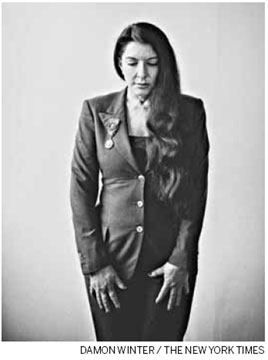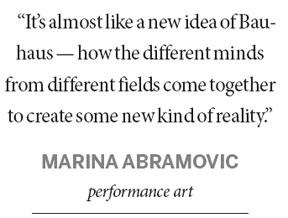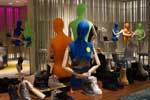An artist plans an institute
Updated: 2013-11-24 07:03
By Sarah Lyall (The New York Times)
|
|||||||||||
In the name of art, she has hung naked on a wall and carved into her own stomach with a razor. She has masturbated in a museum; scrubbed at a pile of bloody, maggoty bones in a fetid basement; stood still while strangers put a gun to her head and stabbed her with thorns; and sat silently for seven hours a day as a succession of people lined up to bask in her aura at the Museum of Modern Art.
And now, Marina Abramovic, the performance artist, is embarking on perhaps the most ambitious project in her 40-year career. In the small town of Hudson, New York, she plans to construct the Marina Abramovic Institute: a mecca for artists, scientists and thinkers, as well as people willing to put on white lab coats and undergo three hours of mind-and-body cleansing exercises.

The plans reflect the turn Ms. Abramovic has taken in recent years, in a career of two distinct parts. Part 1: Ms. Abramovic, the avant-garde, inward-looking Belgrade-born experimentalist, stretching the boundaries by subjecting herself to punishing physical and mental extremes. Part 2: Ms. Abramovic, the celebrity darling, collaborating with movie, pop and hip-hop stars.
All this has not been universally acclaimed. Some artists and critics are accusing Ms. Abramovic of cultivating something suspiciously like a cult of personality. She seems so enamored of the spotlight, they say - so caught up in dancing with Jay-Z, doing mind-cleansing exercises with Lady Gaga and hanging out with the actor James Franco - that she is in danger of betraying not only her own roots but also, perhaps, the true nature of performance art itself. The term refers broadly to live experimental pieces that are not theater and that tend to emphasize the direct, unmediated relationship between artist and audience. In the 1970s, when performance art became acknowledged as a legitimate art medium in the United States, many practitioners adhered to the principle that it should never be reperformed or commodified.
"I respect Marina a lot in the overall sense, but I think the art world has lost its mind," said Amelia Jones, a professor of art history at McGill University in Montreal. "I keep wondering what's next - is she going to set up her own small country somewhere?"
Such talk barely ruffles Ms. Abramovic.
"When I stood up from the chair, I was changed," she said in an interview in September, speaking of the moment she rose to her feet at the end of "The Artist Is Present," her 2010 Museum of Modern Art piece. "I knew long duration was the answer to everything for me. And, with this, came the idea of the institute in the most clear form."
Ms. Abramovic, 66, said the institute will not be a celebration of her work per se, but something greater, a "cultural spa."
"It's really about immaterial work, a collaboration between art, science, spirituality and technology," she said. "It's almost like a new idea of Bauhaus - how the different minds from different fields come together to create some kind of new reality."

She intends to remove herself from the institute once its built. The current thinking is to have visitors pay $75 each and pledge to remain in the building for six hours, half of it to be spent undergoing the "Abramovic Method."
The method, Ms. Abramovic explained, flows from exercises she devised to prepare participants to enact or experience art. Examples include swimming naked in a freezing river, expressing anger to a tree or spending an hour drinking a glass of water.
At the institute, visitors will press their bodies against crystals, perhaps, or meditate wearing blindfolds and earplugs.
As she says, the possibilities are endless. "Artists have to be the servant to society," she said, then added: "Ego is a huge obstacle to art."
The New York Times
(China Daily 11/24/2013 page9)
Today's Top News
Japanese PM concerned over China's air defense zone
Premier Li heads west on opening-up tour
China, EU tap market in urbanization partnership
Xi urges work safety check after fatal blasts
Qingdao continues recovery
1.12m seek government jobs
Deal reached in Iranian nuke talks
Roar of the East being heard
Hot Topics
Lunar probe , China growth forecasts, Emission rules get tougher, China seen through 'colored lens', International board,
Editor's Picks

|

|

|

|

|

|





